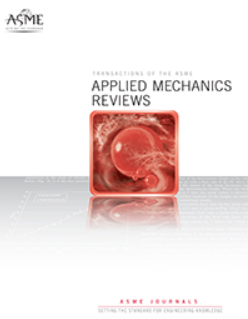Electro-Chemo-Mechanical Challenges and Perspective in Lithium Metal Batteries
IF 16.1
1区 工程技术
Q1 MECHANICS
引用次数: 5
Abstract
The development of next-generation batteries, utilizing electrodes with high capacities and power densities requires a comprehensive understanding and precise control of material interfaces and architectures. Electro-chemo-mechanics plays an integral role in the morphological evolution and stability of such complex interfaces. Volume changes in electrode materials and the chemical interaction of electrode/electrolyte interfaces result in non-uniform stress fields and structurally-different interphases, fundamentally affecting the underlying transport and reaction kinetics. The origin of this mechanistic coupling and its implications on degradation is uniquely dependent on the interface characteristics. In this review, the distinct nature of chemo-mechanical coupling and failure mechanisms at solid-liquid interfaces and solid-solid interfaces is analyzed. For lithium metal electrodes, the critical role of surface/microstructural heterogeneities on the solid electrolyte interphase (SEI) stability and dendrite growth in liquid electrolytes, and on the onset of contact loss and filament penetration with solid electrolytes (SEs) is summarized. With respect to composite electrodes, key differences in the microstructure-coupled electro-chemo-mechanical attributes of intercalation- and conversion-based chemistries are delineated. Moving from liquid to solid electrolytes in such cathodes, we highlight the significant impact of solid-solid point contacts on transport/mechanical response, electrochemical performance, and failure modes such as particle cracking and delamination. Lastly, we present our perspective on future research directions and opportunities to address the underlying electro-chemo-mechanical challenges for enabling next-generation lithium metal batteries.锂金属电池的电化学-机械挑战与展望
利用高容量和功率密度电极的下一代电池的开发需要对材料界面和结构的全面理解和精确控制。电化学力学在这种复杂界面的形态演变和稳定性中起着不可或缺的作用。电极材料的体积变化和电极/电解质界面的化学相互作用导致应力场不均匀和界面相结构不同,从根本上影响了潜在的传输和反应动力学。这种机械耦合的起源及其对降解的影响是唯一依赖于界面特性的。本文分析了固-液界面和固-固界面化学-力学耦合的独特性质和破坏机制。对于锂金属电极,总结了表面/微观结构的非均质性对固体电解质界面相(SEI)稳定性和枝晶生长的关键作用,以及对固体电解质(SEs)接触损失和灯丝渗透的发生的关键作用。对于复合电极,在微观结构耦合电化学-机械属性的插层和转化为基础的化学描述的关键差异。在这种阴极中,从液体电解质到固体电解质,我们强调了固体-固体点接触对传输/机械响应、电化学性能和失效模式(如颗粒破裂和分层)的重要影响。最后,我们提出了我们对未来研究方向和机会的看法,以解决实现下一代锂金属电池的潜在电化学机械挑战。
本文章由计算机程序翻译,如有差异,请以英文原文为准。
求助全文
约1分钟内获得全文
求助全文
来源期刊
CiteScore
28.20
自引率
0.70%
发文量
13
审稿时长
>12 weeks
期刊介绍:
Applied Mechanics Reviews (AMR) is an international review journal that serves as a premier venue for dissemination of material across all subdisciplines of applied mechanics and engineering science, including fluid and solid mechanics, heat transfer, dynamics and vibration, and applications.AMR provides an archival repository for state-of-the-art and retrospective survey articles and reviews of research areas and curricular developments. The journal invites commentary on research and education policy in different countries. The journal also invites original tutorial and educational material in applied mechanics targeting non-specialist audiences, including undergraduate and K-12 students.

 求助内容:
求助内容: 应助结果提醒方式:
应助结果提醒方式:


